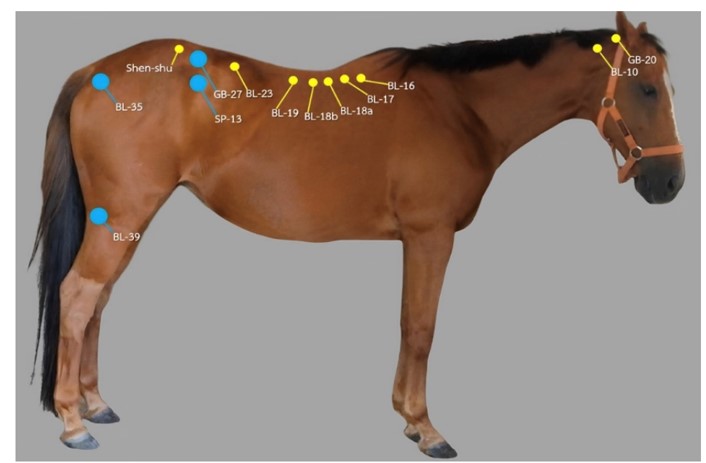Diagnosis of hindlimb lameness using acupuncture points in sport horses https://doi.org/10.12982/VIS.2025.041
Main Article Content
Abstract
The detection of hindlimb lameness is usually considered to be more difficult than the forelimb lameness; thus, it tends to be overlooked. Therefore, an alternative diagnostic method employing acupuncture points for diagnosis of hindlimb lameness is being considered. The objective of this study was to identify the diagnostic acupoints associated with hock pain in sport horses with hindlimb lameness. In this study, 33 sport horses from polo and riding activities were examined for hock pain through acupuncture diagnosis (AD), subjective lameness examinations (SE) by experienced equine veterinarians’ opinions, and objective lameness examinations (OE) using body-mounted inertial sensor systems. From 33 horses, 14 horses with hock pain were included in this study and underwent intra-articular analgesia at the tarsometatarsal joint (TMT block). Each horse was then assessed and graded with the score of improvement for sensitivity of acupuncture points and lameness. From 14 horses, the results indicated that the kappa test for agreement of diagnostic method in determining lame limbs between AD and OE was 71.43% (95%CI = 51.33% - 86.77%), which was significantly higher when compared with the agreement between AD and SE at 64.29% (95%CI = 44.07% - 81.36%). Among the improved horses after TMT block, the score of improvement for sensitivity of acupuncture points also improved significantly on four transpositional acupoints. Based on our findings, Gallbladder-27, Spleen-13, Bladder-39a, and Bladder-39b were determined to be valuable suggestive acupoints for hock pain in horses with different sport activities. In conclusion, the results of this study advocate for the use of acupuncture diagnosis as a supporting lameness diagnosis method.
Article Details

This work is licensed under a Creative Commons Attribution 4.0 International License.
Publishing an article with open access in Veterinary Integrative Sciences leaves the copyright with the author. The article is published under the Creative Commons Attribution License 4.0 (CC-BY 4.0), which allows users to read, copy, distribute and make derivative works from the material, as long as the author of the original work is cited.
References
Baxter, G.M., Haussler, K.K., 2011. Equine Diagnostic Acupuncture Examination (DAPE). In: Baxter, G.M. (Ed.), Adams and stashak's lameness in horses, (6th edition). Wiley-Blackwell, Iowa, pp. 203-205.
Bell, B.T., Baker, G.J., Foreman, J.H., Abbott, L.C., 1993. In vivo investigation of communication between the distal intertarsal and tarsometatarsal joints in horses and ponies. Vet. Surg. 22(4), 289-292.
Buchner, H.H., Savelberg, H.H., Schamhardt, H.C., Barneveld, A., 1996. Head and trunk movement adaptations in horses with experimentally induced fore- or hindlimb lameness. Equine. Vet. J. 28(1), 71-76.
Dyson, S.J., Ross, M.W., 2011. The Tarsus. In: Ross, M.W., Dyson, S.J. (Eds.), Diagnosis and management of lameness in the horse, (2nd edition). Elsevier Saunders, St. Louis, pp. 508-526.
Gough, M.R., Munroe, G.A., Mayhew, G., 2002. Diffusion of mepivacaine between adjacent synovial structures in the horse. Part 2: tarsus and stifle. Equine. Vet. J. 34(1), 85-90.
Huisheng, X., Holyoak, G.R., 2021. Evidence-based application of acupuncture in equine practice. Am. J. Trad. Chin. Vet. Med. 16(2), 41-52.
Keegan, K.G., Wilson, D.A., Kramer, J., Reed, S.K., Yonezawa, Y., Maki, H., Pai, P.F., Lopes, M.A., 2013. Comparison of a body-mounted inertial sensor system-based method with subjective evaluation for detection of lameness in horses. Am. J. Vet. Res. 74(1), 17-24.
Leelamankong, P., Estrada, R., Mahlmann, K., Rungsri, P., Lischer, C., 2020. Agreement among equine veterinarians and between equine veterinarians and inertial sensor system during clinical examination of hindlimb lameness in horses. Equine. Vet. J. 52(2), 326-331.
Leelamankong, P., Estrada, R.J., Rungsri, P., Wolfgang, S., Müller, C.D.V.S., Lischer, C.J., 2018. Objective evaluation of the response to perineural analgesia of the deep branch of the lateral plantar nerve and intraarticular analgesia of the tarsometatarsal joint in horses with suspected proximal metatarsal pain using body-mounted inertial sensors. J. Equine. Vet. Sci. 70, 91-95.
Mariani, L.P.R., Sampaio, F., Silveira, A.B., Bastos, L.F., Weber, S.H., Michelotto, P.V., 2019. Pressuring of acupoints as a complement to the diagnosis of stifle diseases in horses. J. Acupunct. Meridian. Stud. 12(5), 151-159.
McCormick, W.H., 1998. The origins of acupuncture channel imbalance in pain of the equine hindlimb. J. Equine. Vet. Sci. 18(8), 528-534.
McCracken, M.J., Kramer, J., Keegan, K.G., Lopes, M., Wilson, D.A., Reed, S.K., LaCarrubba, A., Rasch, M., 2012. Comparison of an inertial sensor system of lameness quantification with subjective lameness evaluation. Equine. Vet. J. 44(6), 652-656.
Michelotto, P.V., Bastos, L.F.C., Sotomaior, C.S., Pimpão, C.T., 2014. Acupuncture diagnosis in equine stifle disease. J. Equine. Vet. Sci. 34(8), 967-971.
Pellegrini, D.Z., Müller, T.R., Fonteque, J.H., Souza, L.P., Souza, A.F., Joaquim, J.G.F., 2018. Equine acupuncture methods and applications: a review. Equine. Vet. Educ. 32(5), 268-277.
Pfau, T., Parkes, R.S., Burden, E.R., Bell, N., Fairhurst, H., Witte, T.H., 2016. Movement asymmetry in working polo horses. Equine. Vet. J. 48(4), 517-522.
Ross, M.W., 2011. Movement. In: Ross, M.W., Dyson, S.J. (Eds.), Diagnosis and management of lameness in the horse, (2nd edition). Elsevier Saunders, St. Louis, pp. 64-80.
Schoen, A.M., 2000. Equine acupuncture: incorporation into lameness diagnosis and treatment. In AAEP Annual Convention, San Antonio, 26-29 November 2000.
Schoen, A.M., 2011. Acupuncture. In: Ross, M.W., Dyson, S.J. (Eds.), Diagnosis and management of lameness in the horse, (2nd edition). Elsevier Saunders, St. Louis, pp. 881-892.
Viera, A.J., Garrett, J.M., 2005. Understanding interobserver agreement: the kappa statistic. Fam. Med. 37(5), 360-363.
Wollenman, P., McMahon, P.J., Knapp, S., Ross, M.W., 2011. Lameness in the Polo Pony. In: Ross, M.W., Dyson, S.J. (Eds.), Diagnosis and management of lameness in the horse, (2nd edition). Elsevier Saunders, St. Louis, pp. 1149-1164.
Xie, H., Trevisanello, L., 2007. Equine transpositional acupoints, In: Xie, H., Preast, V. (Eds.), Xie's veterinary acupuncture. Blackwell, Oxford, pp. 27-87.

